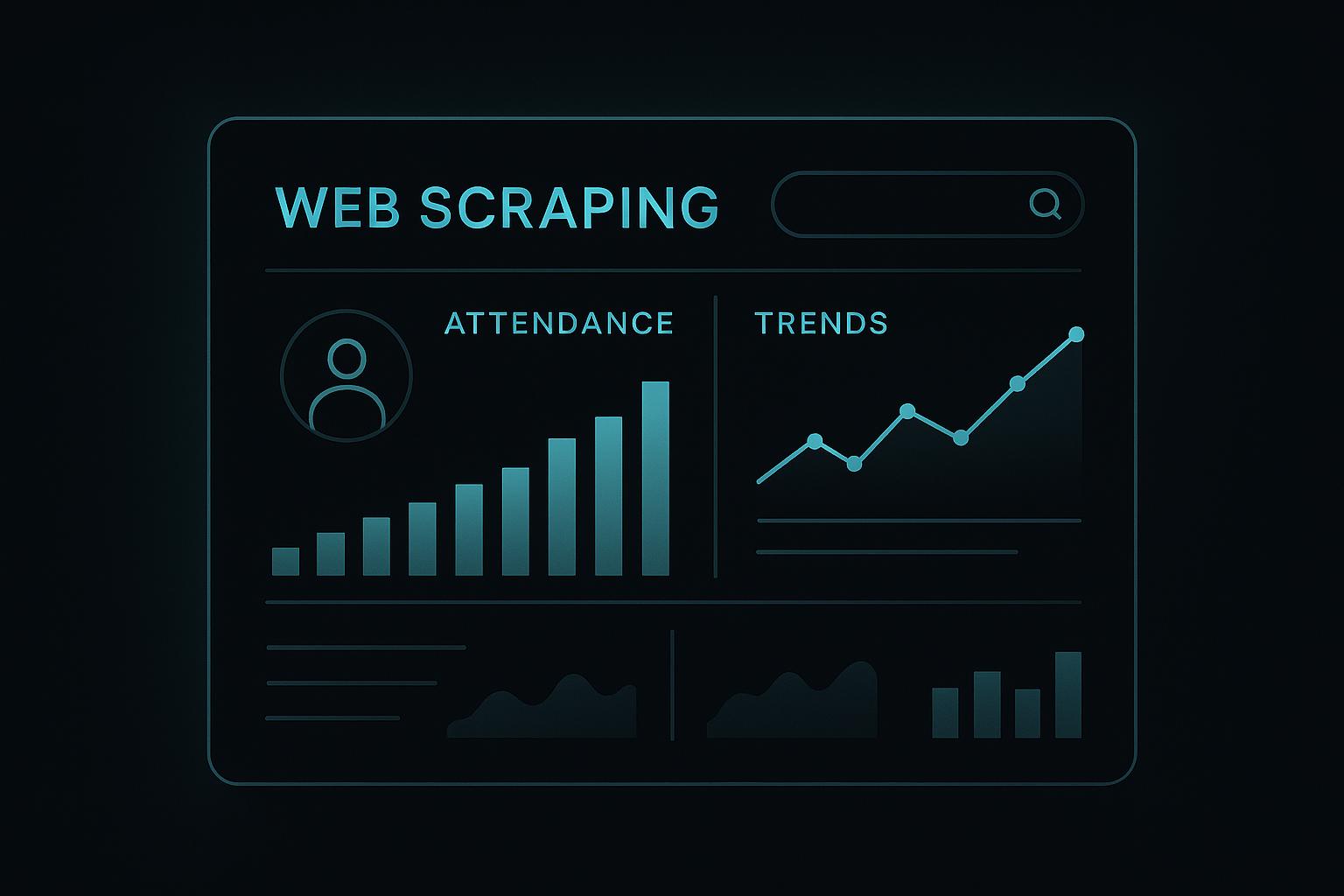Web scraping makes tracking air quality, weather, and water data faster and easier. Tools like InstantAPI.ai automate data collection from sources like NOAA, EPA, and NASA, saving time and reducing errors. Here's how it helps:
- Real-Time Monitoring: Stay updated on air quality, weather patterns, and water conditions.
- Data Integration: Combine data from multiple sources into one dataset.
- Automated Collection: Skip manual efforts with automated pipelines.
- Scalable Analysis: Handle large datasets effortlessly for as little as $0.005 per page scrape.
Quick Uses:
- Air Quality: Monitor pollution for health and emissions initiatives.
- Weather: Optimize retail campaigns or agriculture schedules.
- Water Quality: Detect contamination faster and improve resource management.
Start by identifying trusted data sources (e.g., EPA, NOAA), choosing the right scraping tool, and building a structured data pipeline. Address challenges like accuracy, website restrictions, and large datasets using smart tools and practices. Web scraping is a powerful way to collect and analyze environmental data responsibly.
Web Scraping Weather Data with Python
Common Uses for Environmental Data Scraping
Environmental data scraping is a powerful tool for organizations monitoring ecological changes and working toward better resource management. Here are some of its most common applications:
Tracking Air Quality Data
Scraping air quality data plays a key role in protecting public health. Platforms like the EPA's AirData provide detailed pollution metrics across the U.S., helping organizations track air quality and its health impacts in real time.
Currently, fewer than 40% of governments globally offer real-time air quality data to the public. This gap has driven initiatives like OpenAQ's global monitoring network, which in 2020 processed 500 million data points from 11,000 monitoring stations across 93 countries[1].
"Real-time air quality data helps big polluters work within their corporate responsibility team or to partner with local environmental authorities to design appropriate emissions cutback initiatives." – World Economic Forum
One success story is San Francisco's Brightline Defense, which installed low-cost sensors in single-room occupancy communities. Their scraping system continuously gathers data, allowing real-time air quality monitoring in underserved neighborhoods while supporting community outreach.
Weather and climate data scraping offers similar benefits across industries.
Getting Weather and Climate Data
Scraping weather and climate data has become essential for industries ranging from retail to agriculture. Resources like the National Weather Service and Climate Data Online (CDO) provide rich datasets for informed decision-making.
For instance, weather data helped a major retailer launch a heatwave-triggered promotion in summer 2025, boosting summer product sales by 15%. In agriculture, a company used scraped weather data to refine planting schedules, leading to a 20% increase in crop yield while reducing waste.
| Weather-Based Strategy | Results |
|---|---|
| Heatwave-triggered promotions (Retail) | 15% increase in summer product sales |
| Optimized planting schedule and fertilizer usage (Agriculture) | 20% increase in crop yield while reducing waste |
"Weather impacts nearly every aspect of our daily lives, and for businesses, it's no different. What makes weather data especially powerful is its versatility. From optimizing marketing campaigns based on seasonal shifts to enhancing precision in agriculture, the applications span industries." – Sandro Shubladze, CEO and Founder, Datamam
Water quality monitoring is another area where scraping techniques have made a big impact.
Monitoring Water Quality
Scraping water quality data involves collecting information on physical, chemical, and biological properties. The Water Quality Index (WQI) provides a comprehensive measure based on six parameters: dissolved oxygen (DO), biological oxygen demand (BOD), chemical oxygen demand (COD), total suspended solids (TSS), ammonia levels, and pH.
In 2020, automated data revealed that 66% of rivers maintained good quality, with pollution levels at a decade low of 5%. Putrajaya Lake saw notable improvement, with WQI Class I measurements jumping from 24% to 94% during a period of reduced human activity.
Modern systems now offer real-time detection, replacing older methods that often took days to deliver results. This allows for faster responses to contamination and better water resource management.
How to Start Scraping Environmental Data
Learn how to set up a system to gather environmental data efficiently with these steps:
Finding Data Sources
The first step in scraping environmental data is identifying trustworthy sources. Many U.S. agencies provide structured datasets that are regularly updated. Here's a quick overview:
| Organization | Data Type | Update Frequency | Data Format |
|---|---|---|---|
| EPA AirData | Air quality metrics | Hourly | JSON/CSV |
| NOAA Climate Data | Weather patterns | Daily | XML/CSV |
| USGS Water Data | Water quality | Real-time | JSON/REST |
| NASA Earth Data | Satellite imagery | Weekly | GeoTIFF/NetCDF |
When assessing data sources, focus on:
- How often the data is updated
- Accuracy and completeness of the information
- Access to historical datasets
- API documentation quality
- Any rate limits or access restrictions
Once you've identified reliable sources, the next step is choosing a tool to extract the data.
Picking Scraping Tools
Using the right tool is crucial for efficient data collection. InstantAPI.ai is a popular choice for environmental data scraping, offering features like:
- Automated conversion of raw HTML into structured JSON
- Built-in rate limiting to comply with website policies
- Data validation to ensure accuracy
- Scheduled scraping for recurring data collection
This platform works well for both small-scale monitoring and larger research projects, making data scraping more accessible and cost-effective.
After selecting a tool, it’s time to structure and automate your data pipeline.
Building Your Data Pipeline
With a tool in place, the next step is to design your data pipeline. Here’s how:
-
Define Your Data Schema
Create a schema to outline the exact data you need. For example:
air_quality: { pm25: float, ozone: float, timestamp: datetime, location: { latitude: float, longitude: float, city: string } }. -
Set Up Data Collection
Configure your scraping tool to target specific URLs, handle pagination, define extraction rules, and manage error handling and rate limits. -
Process the Data
Clean and normalize the data, convert units if needed, standardize time zones, validate the information, and store it in formats like JSON or CSV.
sbb-itb-f2fbbd7
Solving Common Scraping Problems
When gathering environmental data through web scraping, you might face a few hurdles. Once your data pipeline is ready, focus on addressing these issues to ensure consistent and reliable data collection.
Ensuring Data Accuracy
To maintain accuracy in your metrics, try these methods:
- Range checks: Set minimum and maximum thresholds to catch unusual values.
- Format validation: Confirm data types and units are correct.
- Cross-referencing: Compare data from multiple sources for consistency.
- Temporal analysis: Spot irregular patterns in time-series data.
For critical measurements, automated alerts can help you flag anomalies - like sudden temperature jumps - so you can review them quickly.
Overcoming Website Restrictions
Some websites limit access to manage traffic. Tools like InstantAPI.ai simplify this process with features such as:
- Automatic proxy rotation: Access over 65 million IPs to avoid blocks.
- CAPTCHA solving: Keep your scraping uninterrupted.
- Smart request timing: Prevent hitting rate limits.
- Geotargeting: Access region-specific data seamlessly.
Managing Large Datasets
Handling large volumes of data can be tricky, but these strategies can help:
- Break your data into smaller chunks (e.g., by month or region) for better query performance.
- Convert raw data into structured JSON format to keep everything consistent.
- Regularly check your pipeline and monitor processing times to ensure smooth operations.
At just 0.5¢ per page scrape, InstantAPI.ai provides an affordable way to maintain reliable environmental monitoring while managing your data effectively.
Tips for Better Data Collection
Once you’ve set up a solid data pipeline, you can fine-tune your approach to gathering environmental data. Focus on simplifying cleanup, keeping your code functional, and combining data from different sources effectively.
Simplifying Data Cleanup
Save time by automating the cleaning process with these steps:
- Convert temperature and measurement units to match local standards.
- Use the MM/DD/YYYY format for dates across all datasets.
- Remove special characters and apply consistent text formatting.
- Leverage regular expressions to create reusable cleaning templates.
For air quality data, set up validation rules to flag readings that stray too far from expected levels. This ensures unusual data points get manual attention.
Keeping Scraping Code Functional
Websites often update their structures, so regular maintenance of your scraping scripts is essential. Here’s how to keep them reliable:
- Schedule automated tests to confirm data extraction is accurate.
- Track HTTP response codes to spot API updates or issues.
- Add clear comments to document selector patterns in your code.
- Keep a changelog of site updates to track changes and adapt quickly.
To improve efficiency, schedule scraping during off-peak hours (like 2 AM to 5 AM local time). This reduces server strain and increases your chances of success.
Combining Data from Different Sources
Once your data is clean, bring it together for a unified analysis. Set up a central data warehouse that can handle various formats. Here’s a quick guide:
| Data Type | Source Format | Standardization Steps |
|---|---|---|
| Air Quality | JSON/CSV | Normalize timestamps, convert units |
| Weather | XML/API | Map locations, adjust temperatures |
| Water Quality | HTML tables | Validate data, standardize units |
Track every data point with a unique identifier and maintain an audit trail to log its origin and any changes made. This makes it easier to resolve discrepancies and ensures your data remains reliable.
Wrapping Up
The earlier sections highlighted practical uses and technical approaches that showcase how web scraping supports environmental monitoring efforts.
Web scraping plays a key role in tracking our planet's health. By automating data collection, researchers and agencies can monitor changes in air quality, weather trends, and water conditions more efficiently.
Effective environmental data collection depends on reliable tools. InstantAPI.ai simplifies this process, allowing organizations to expand their monitoring capabilities while maintaining high data accuracy.
To use web scraping responsibly, keep these practices in mind:
- Respect data source terms of service
- Apply proper rate limiting
- Verify the accuracy of collected data
- Document data sources clearly
- Adhere to ethical data collection standards
These practices ensure responsible data gathering while addressing access challenges.
As environmental concerns grow, gathering and analyzing data efficiently will be more important than ever. From tracking urban air quality to studying climate trends across regions, web scraping supports informed, data-driven decisions for addressing environmental issues.


